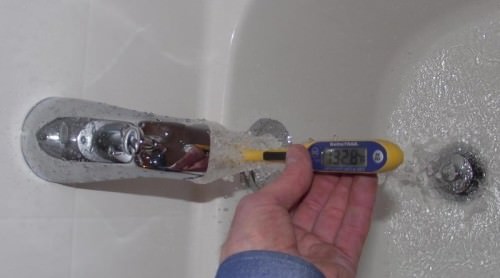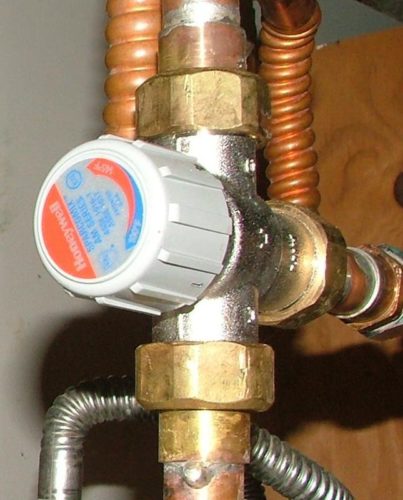Charles Buell Inspections Inc |
How hot is the water at your tub/shower? Posted: 24 Aug 2014 08:38 AM PDT Modern construction regulations require that some means of limiting water temperatures of the hot water being delivered to tubs, showers and bidets be installed. This is achieved by installing pressure-balance, thermostatic-mixing or combination pressure-balance/thermostatic-mixing valve at the fixtures themselves. On a recent inspection I was not surprised to find the water temperature at the bathroom sink to be 147 degrees Fahrenheit. It is very common to find water temperatures in homes set way too high. 147 degrees will cause 2nd and 3rd degree burns in under 2 seconds. You could not put your baby (or granny) in the bath and out of the bath in 2 seconds. The baby might not even start screaming in that short of time (and granny might just have a heart attack)–resulting in the baby being in there even longer. What did surprise me about the water temperature was that it was the same temperature at the tub. The following picture of my thermometer shows the water temperature–132 degrees Fahrenheit which is way too hot and it eventually got all the way up to 147 degrees Fahrenheit. This could lead one to think that perhaps the wrong valve was installed–or that the correct valve was installed but was not adjusted properly. In new construction there should just plain never be water this high at the tub fill. Of course the same is true of any age construction but in new construction it is something that needs to be "fixed" as opposed to being "upgraded." Some homes have tempering valves that limit the water temperature from the source of the hot water (water heater), but this type of in-line tempering valve is not meant as a replacement for limiting high temperatures at the points of use. This tempering valve is adjustable—and should be set at under 120 degrees Fahrenheit. The valve functions by mixing a little cold water into the hot water. These valves are a great way to give a layer of protection to older homes that do not have fixtures at the points of use that can limit high water temperatures. Current regulations require that water delivered to tubs and showers be no greater than 120 degrees Fahrenheit and that water delivered to bidets be no more than 110 degrees Fahrenheit. It is the homeowner's responsibility to make sure that hot water temperatures are safe–and they should be checked periodically–and have them adjusted accordingly. It can be very difficult in the context of a home inspection to determine or verify proper water temperatures. Temperatures certainly will not be verified at every location. Water temperature should be taken at the beginning of the inspection and at the end of the inspection at a minimum, because a huge percentage of the time the tested temperature at the beginning of the inspection will be much lower than the end of the inspection after the water heater has fired and brought the whole tank up to the highest temperature. This scenario is especially true of unoccupied homes. Do you know what your water temperature is? By Charles Buell, Real Estate Inspections in Seattle |
Duane Turner
Office: 09 811 8018
Mobile: 027 376 4806
duane.turner@abuyerschoice.com
www.waitakere.abuyerschoice.com
Waitakere & Surrounding Areas





No comments:
Post a Comment